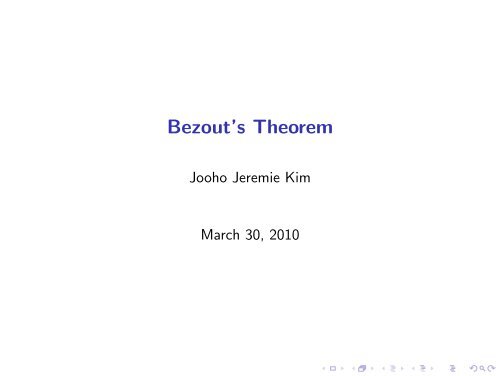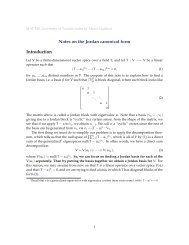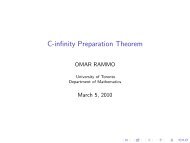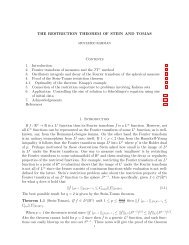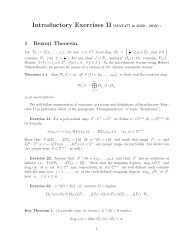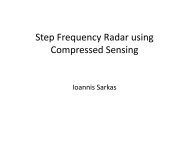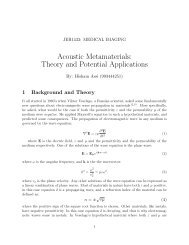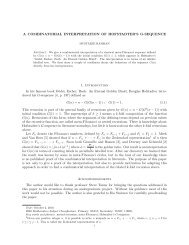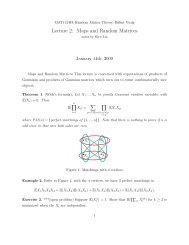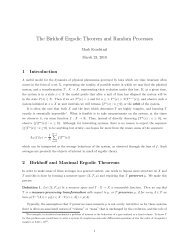You also want an ePaper? Increase the reach of your titles
YUMPU automatically turns print PDFs into web optimized ePapers that Google loves.
Bezout’s <strong>Theorem</strong><br />
Jooho Jeremie Kim<br />
March 30, 2010
1/11<br />
Say, P := (P1, · · · , Pn): C n → C n , assume #P −1 (0) < ∞<br />
Then (introductory lectures, October 2009) ⇒<br />
∞ > dimC<br />
C[x] <br />
=<br />
(P) · C[x]<br />
a∈P−1 dimC<br />
(0)<br />
C[x]a<br />
(P) · C[x]a<br />
deg Pj<br />
Let LPj(x) := HPj(0, x), where HPj(x0, x) := x0 · Pj( x<br />
x0 ).<br />
Assume also {LP1(x) = · · · = LPn(x) = 0} = {0} (∗)<br />
(so called “no solutions at ∞”) for C n ↩→ P n ⇒
Bezout’s <strong>Theorem</strong><br />
Proof of (*) ⇒ a.<br />
2/11<br />
a. P : C n → C n is proper finite to one<br />
b. <br />
deg C a P = deg P = <br />
deg Pj<br />
a∈P −1 (0)<br />
1≤j≤n<br />
Say, ξk ∈ C n , assume ξk ↗ ∞ and all |Pj(ξk)| ≤ C < ∞<br />
ak := ξk<br />
ξk ∈ S 1 ⇒ ∃ subsequence ak → a = 0<br />
ρk := 1<br />
ξk → 0, 0 < dj = deg Pj
3/11<br />
Then it follows ∀j, Pj(ξk) = [Pj( ak<br />
ρk<br />
) · ρdj<br />
k<br />
] · 1<br />
ρ d j<br />
k<br />
= HPj(ρk, ak) · 1<br />
ρ d j<br />
k<br />
Therefore, |HPj(ρk, ak)| ≤ C · ρ dj<br />
k ⇒ LPj(a) = 0 ⇒?! √<br />
Now prove b. in three steps.<br />
Step 1 is deg C 0 LP = deg C 0 HP, where<br />
LP := (LP1, · · · , LPn): C n → C n<br />
HP : C n+1 → C n+1<br />
HP(x0, x) := (x0, HP1(x0, x), · · · , HPn(x0, x))
4/11<br />
y is a regular value for LP ⇒ (0, y) is regular value for HP<br />
⇒(obviously) #HP −1 (0, y) = #LP −1 (y), which suffices.<br />
Indeed<br />
Step 1. completed. √<br />
∂HP<br />
∂(x0, x) |x0=0<br />
⎛<br />
1| ∗ ∗<br />
⎞<br />
∗<br />
⎜<br />
= ⎜0|<br />
⎝0|<br />
0|<br />
∂HP<br />
∂x<br />
⎟<br />
⎠ |x0=0<br />
and ∂HP<br />
∂x (0, x)|x0=0 = ∂LP<br />
∂x (x)
Step 2 is deg P = deg C 0 HP<br />
5/11<br />
suffices to find a regular value a ∈ C n for map P and<br />
a regular value (b0, b) ∈ C n+1 for map HP<br />
such that each aj = bj/b dj<br />
0 , where dj := degPj.<br />
Step 2 follows since regular values are open dense sets<br />
and map (y0, y1, · · · , yn) → (y0, y d1<br />
0 · y1, · · · , y dn<br />
0 · yn) is<br />
a diffeomorphism of C ∗ × C n .<br />
Step 2. completed. √
6/11<br />
Step 3 is deg C 0 LP = <br />
j deg Pj. Let φ := LP ⇒ φ −1 (0) = {0}<br />
Proof is split into<br />
Thm. 0 = Jφ = deg C 0 φ · δ(x, 0) mod (φ) · C{x}<br />
(with δ(x, y) from 2 below). Claim. Jφ = <br />
1≤j≤n dj · δ(x, 0).<br />
Proof of Thm<br />
1. Using Mumford’s Lemma, ∃ open U ∋ 0, V ∋ 0 s.th.<br />
φ := φ|U : U → V proper. (and U ∩ φ −1 (0) = {0})<br />
Using Key Lemma from Mitsuru’s talk<br />
⇒ Z := Cr.Val(φ):= φ({Jφ = 0}) ⊂ V closed analytic.
2. A(x, y) := 1<br />
0<br />
7/11<br />
∂φ<br />
∂x (tx + (1 − t)y)dt ⇒ A(x, y) · (x − y) =<br />
φ(x) − φ(y) and Jφ(x) = δ(x, x), where δ(x, y) := det A(x, y)<br />
3. Let h(x, z) := <br />
{y:φ(y)=z} δ(x, y) ⇒ h is C−analytic on V \ Z<br />
and bounded ⇒ h analytic on V (Riemann Extension Thm)<br />
4. h(x, 0) = deg C 0 φ · δ(x, 0) due to φ| −1<br />
U (0) = {0} .<br />
5. Jφ(x) − h(x, z) = 0 if z = φ(x) /∈ Z<br />
⇒ Jφ(x) − h(x, z) ∈ (z − φ(x)) · C{x, z}<br />
6. Set z = 0 ⇒ Jφ(x) − (deg C 0 φ) · δ(x, 0) ∈ (φ) · C{x}, as<br />
required.
8/11<br />
Recall.<br />
deg LPj = deg Pj = dj, φj := LPj ⇒ ∂φj<br />
∂xi (tx) = tdj −1 ∂φj<br />
∂xi (x)<br />
Claim Jφ = d1 · · · dn · δ(x, 0)<br />
Cor. Since Jφ /∈ (φ) · C{x} (Slides 9-11) ⇒ deg C 0 φ = d1 · · · dn<br />
Proof. Explicit calculation<br />
A(x, 0) :=<br />
1<br />
⎡<br />
0<br />
1<br />
d1<br />
⎢<br />
= ⎣<br />
0<br />
{ ∂φj<br />
∂xi<br />
. ..<br />
⎡<br />
t<br />
1<br />
⎢<br />
(tx)}dt = ⎣<br />
0<br />
d1−1 0<br />
. ..<br />
0 tdn−1 ⎤<br />
⎥<br />
⎦ ( ∂φ<br />
∂x (x))dt<br />
⎤<br />
0<br />
⎥<br />
⎦ ( ∂φ<br />
∂x (x))<br />
√<br />
1<br />
dn
9/11<br />
Thm. φ : (C n , 0) → (C n , 0), φ −1 (0) = {0} ⇒ Jφ(x) /∈ (φ) · C{x}<br />
Thm ⇐ Claim. h ∈ C{x} ⇒ Hh(z) := <br />
x∈φ−1 h(x)<br />
(z) Jφ(x) ∈ C{z}<br />
Indeed, HJφ ≡ degC 0 φ = 0, while g = <br />
j φj · hj ∈ (φ) · C{x} ⇒<br />
Hg (z) = <br />
j zj · Hhj (z) ∈ (z) · C{z}, as required.<br />
Proof of Claim X := φ| U ({J φ|U = 0}).<br />
(Note X = { <br />
x∈φ| −1<br />
U (z) Jφ(x) = 0} ⊂ V )<br />
φ|Jφ=0 : {Jφ = 0} → X proper fin. to one ⇒ dimC Z < dimC X<br />
where Z = φ| U (Sing{Jφ = 0}) ∪ SingX ∪ Cr.Val(φ| Jφ=0 ) analytic.
10/11<br />
Step 1. ∀a ∈ {Jφ|U = 0} \ φ| −1<br />
U (Z), ∃ local coord. changes s.th.<br />
a = 0, φ(a) = 0, {Jφ = 0} = {x1 = 0}, X = {z1 = 0}<br />
⇒ φ(0, x2, · · · , xn) = (0, x2, · · · , xn). Also Jφ ≈ x k 1<br />
Say φ1(x1, x2, · · · , xn) := x d 1 · g(x), g(x) /∈ (x1) · C{x} (d ≥ 1)<br />
and θ(x) := det[ ∂(φ2,··· ,φn)<br />
∂(x2,··· ,xn) ] |x1=0 = 1 ⇒ k = d − 1, g(0) = 0 .<br />
Say, h(x) d = g(x) ⇒ ( coord. change x ↦→ (x1h(x), φ2, · · · , φn))<br />
Near a, we may assume φ(x) = (x d 1 , x2, · · · , xn)<br />
Step 2. h ∈ Hol(U) ⇒ Hh ∈ Hol(V − X ).<br />
But moreover, <br />
x1:x d k−d+1<br />
x<br />
1 =z1 1 = 0 ∀k + 1 /∈ d · Z+
11/11<br />
with h(x) = ∞ k=0 hk(x2, · · · , xn)x k 1 near a (Jφ(x) = x d−1<br />
1 · d) ⇒<br />
Near a, <br />
x∈φ −1 (z)<br />
= <br />
(k−d+1)|d hk(z2, · · · , zn) · z k−d+1<br />
d<br />
1<br />
h(x)<br />
Jφ(x) = ∞<br />
k=0 hk(z2, · · · , zn) <br />
x d 1 =z1<br />
⇒ Hh(z) extends as holom. to V \ Z, dimC Z ≤ n − 2<br />
(Hartog’s Thm) Hh ∈ Hol(V ), done. √<br />
x k−d+1<br />
1<br />
d<br />
=


